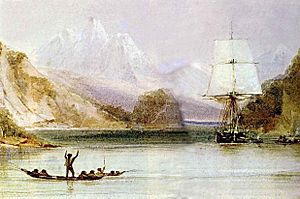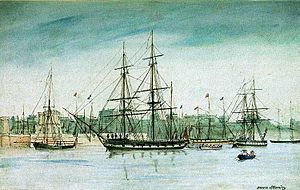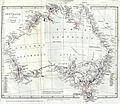HMS Beagle facts for kids

HMS Beagle in the Straits of Magellan at Monte Sarmiento, reproduction of R. T. Pritchett's frontispiece from the 1890 illustrated edition of The Voyage of the Beagle.
|
|
Quick facts for kids History |
|
|---|---|
| Ordered | 16 February 1817 |
| Cost | £7,803 |
| Laid down | June 1818 |
| Launched | 11 May 1820 |
| Commissioned | 1820 |
| Decommissioned | 1845, transferred to Coastguard |
| Fate | Sold and broken up 1870 |
| General characteristics | |
| Class and type | Cherokee-class brig-sloop |
| Tons burthen | 235 bm; 242 for second voyage |
| Length | 90.3 ft (27.5 m) |
| Beam | 24.5 ft (7.5 m) |
| Draught | 12.5 ft (3.8 m) |
| Sail plan | Brig (barque from 1825) |
| Complement | 120 as a ship-of-war, 65 plus 9 supernumeraries on second voyage |
| Armament | 10 guns, reduced to 6 guns for first survey voyage, changed to 7 guns during second survey voyage |
HMS Beagle was a famous ship of the Royal Navy, the navy of the United Kingdom. It was a type of ship called a Cherokee-class brig-sloop. The Beagle was built and launched on May 11, 1820, from the Woolwich Dockyard near the River Thames in England. This ship is most famous for its second voyage, which carried the well-known scientist Charles Darwin.
Contents
First Journey: Mapping South America (1826–1830)
On May 22, 1826, the Beagle began its first important journey. Its mission was to map the coastlines and waters of Patagonia and Tierra del Fuego in South America. These maps were very important for other ships to navigate safely.
During this trip, the crew discovered a body of water that they named the Beagle Channel, after their ship. Sadly, the first captain, Pringle Stokes, died during the voyage. Robert FitzRoy then became the new captain. The Beagle returned to England on October 14, 1830, after completing its mission.
Second Journey: Darwin's Great Adventure (1831–1836)

The Beagle started its second and most famous journey on December 27, 1831. Captain FitzRoy wanted someone to join him on the voyage for company and to study nature. He found a young scientist named Charles Darwin.
On this long trip, the crew continued to map parts of South America. Darwin spent his time exploring the land, collecting plants and animals, and observing the natural world. His observations during this voyage helped him develop his famous ideas about evolution.
The Beagle finally returned to Falmouth, Cornwall, England, on October 2, 1836.
Darwin's Famous Book
Charles Darwin kept a detailed diary of everything he saw and did on this journey. He later rewrote his notes into a book called Journal and Remarks. This book was published in 1839. It was the third part of the official story of the expedition.
The book became very popular and was printed many times with different titles. Today, it is best known as The Voyage of the Beagle. It is a very important book in the history of science.
Third Journey: Exploring Australia (1837–1843)

In 1837, the Beagle began its third major journey. This time, its mission was to map the coast of Australia. Commander John Clements Wickham was in charge of the ship.
The crew started by mapping the western coast of Australia. They explored the area between the Swan River (where the city of Perth is today) and the Fitzroy River. After that, they mapped both sides of the Bass Strait, a sea passage between mainland Australia and Tasmania.
In May 1839, they sailed north to map the shores of the Arafura Sea, which is opposite the island of Timor. This long journey finally ended in 1843.
Naming Places in Australia
During this mapping trip, many places along the Australian coast were given names. Many of these names honored important people or members of the Beagle's crew. For example, Commander Wickham named Port Darwin to honor Charles Darwin.
A settlement grew there, which was first called Palmerston in 1869. Later, in 1911, it was renamed Darwin, after the famous scientist. The Beagle Gulf was also named after the ship during this survey.
Images for kids
See also
 In Spanish: HMS Beagle para niños
In Spanish: HMS Beagle para niños




